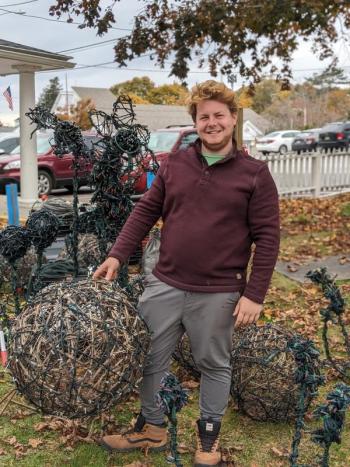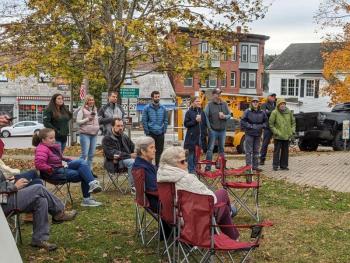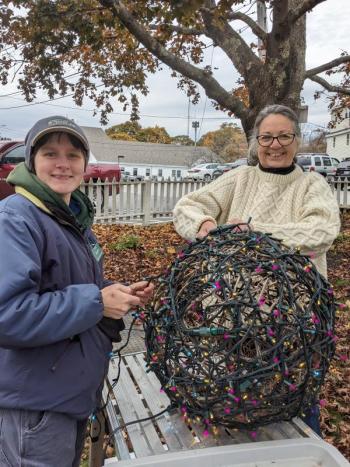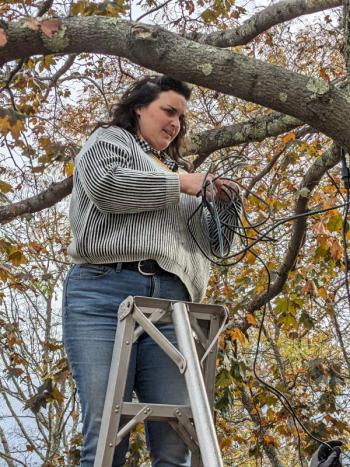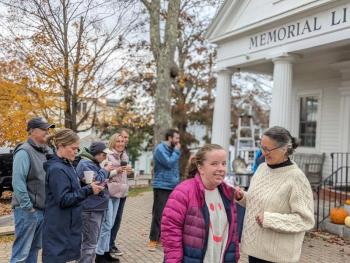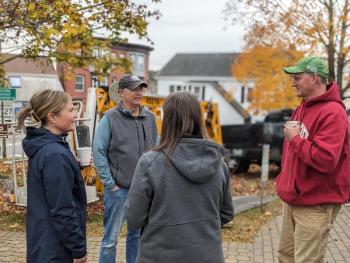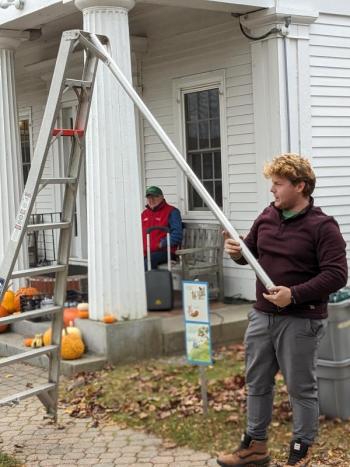McHale gives talk on holiday lighting design at BHML
Brent McHale, horticulturist and lighting designer for Coastal Maine Botanical Gardens (CMBG), gave a lecture on lighting design, installation and safety at Boothbay Harbor Memorial Library Saturday, Nov. 4, followed by holiday lights installation on the property. About 30 people attended the talk.
McHale is responsible for overseeing the hanging of about 12,000 strands, over 750,000 bulbs at CMBG. He spends six months a year handling lights for Gardens Aglow, starting in October when the Gardens begins hanging lights and ending in March when the last strand is stored. “I’m excited for the partnership with the Boothbay Harbor Memorial Library, starting this year and into the future, bringing light, beauty and joy into the harbor,” he said.
For a thoughtful, cohesive design – color, spacing and juxtaposition should be considered, he said, beginning his talk. “Think about where you see the lights from, walk around the property and get a full picture of every point of view. Then look at your lights. Sometimes it helps to take them all out of storage boxes and see what you have before you install any. That way you can mentally place them, and then decide what you are capable of doing.”
Spacing is important when wrapping trees in strand lights, and it’s labor intensive; often, up-lights and spotlights stand out and create the same effect, but are much easier to install, he advised. “Time spent versus impact should be considered. Often there are ways to simplify the amount of effort and still capture the look you’re going for,” he said.
McHale also suggested remedies for sparse sections of your yard. At the Gardens, if he had an empty spot where he needed height, he would use dead trees and branches to build a structure for lights. “No one knows it’s dead,” he laughed. “Might as well use it.” He also said chicken wire is cheap, sturdy and very handy for creating fun designs or reinforcing structures that might not support the weight of the lights.
McHale, now in his fifth year with Gardens Aglow and his second year as the lead designer, offered advice on using color for impact. “At the Gardens we use color to transition between spaces, and this can also work on a yard-sized scale. For color selection, hold different strands next to each other and see how they compliment each other. Reds, pinks, yellows and oranges are warm colors, while white, blue, purple, and aqua are cool colors. Overlap cool and warm colors to create a visual transition. Lights with special effects should be used to accent, don’t overuse them. When wrapping a big tree, and using two different colors, space the first strand in bands four to 6 inches wide, then use the second color in the center of those bands. If you angle those bands, you create a blurred affect where the colors merge together. If you use horizontal bands, you’ll create a striped effect.”
To create an ombre effect across an entire tree, use color 1 solidly across the bottom third of the tree. The middle third of the tree should use a combination of color 1 and color 2 in equal proportions, and finally, the top third of the tree should be color 2 solidly.
“Many people like a classy all-white theme. It is elegant, but even within all white designs, some color variation goes a long way. For example, strands of “Enchantment,” one of my favorites, contains three shades of white, some warmer, some cooler, on each strand and they look fantastic.”
CMBG has provided Boothbay Harbor Region Chamber of Commerce with surplus S4 “Enchantment” and “Aurora” strands to sell at cost to the public. They are $12 for a 25-foot strand, S4 manufacturers commercial grade lights sold only through wholesale. McHale said CMBG typically gets seven to 10 years out of these light strands. “The less you handle them, the longer life they have. If you can store trees and balls and other decorations with the lights on them, you’ll save time next year and extend the life of your lights.” He suggested Gorilla Tape or standard electrical tape for water proofing connections between strands as a way to also extend the life of the lights.
McHale advised, an orchard ladder is the best for stringing lights at home. “Don’t push it on the ladder. You should always have three points of contact on the ladder, keeping your center of gravity on the ladder. Lean as little as possible. It takes an extra minute, but if you can’t reach something, move the ladder closer. And make sure the ladder steps are level. That’s how you know you have solid footing.”


